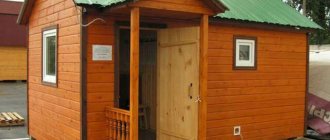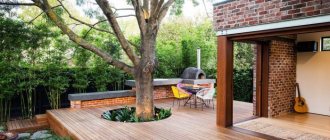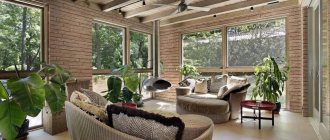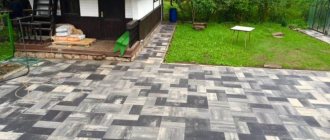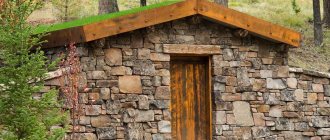The summer kitchen at the dacha has a special role: in the hot season it is good for cooking and dining, and in the fall it turns into a grill bar. There are a great variety of kitchen designs and modifications - you can purchase a ready-made kitchen for a country house and entrust the installation to professionals, or try to assemble a simple canopy yourself.
Brief overview of the article
Types of summer kitchens
Depending on the location, summer kitchens can be divided into two large groups: adjacent to the main house and free-standing.
Do I need to obtain permission to add an extension to a house?
According to the rules of Article 51 of the Town Planning Code, a reconstruction permit is issued in the same way as a building permit . It is issued by the local administration on the basis of documents.
Interesting: Obligation to confirm the young family program
Sometimes homeowners are no longer satisfied with the internal layout, and they decide to rebuild their home, for example, by increasing the usable area or adding a floor . In this case, obtaining permission is necessary, because the extension to the house may subsequently be declared illegal, which means it will be required to be demolished. Meanwhile, permission to change the structure of a house is issued in the same way as a building permit according to the norms of the Town Planning Code.
Kitchen as part of the home
These types of summer kitchens are suitable for those who already have verandas and terraces. As a rule, they share at least one common wall with the house. The veranda can be glazed or it is possible to remove the frames for the summer. Here you can arrange additional sleeping places.
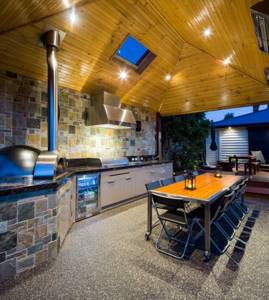
Summer kitchens adjacent to the house have a number of advantages:
- close proximity to the main house;
- the floor and walls are already there, they do not need to be built additionally;
- protection from wind and precipitation from several sides;
- It’s not hot in summer, but in winter the space turns into a storage room.
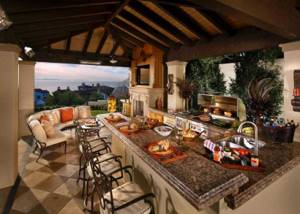
You can install expensive equipment in the adjacent summer kitchen - it will not be damaged by precipitation. The main disadvantage of a kitchen at home is that the ability to cook over an open fire is limited by fire safety requirements.
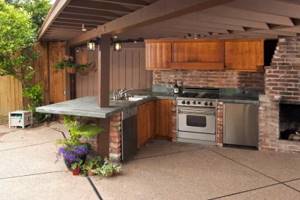
How to properly legalize an extension to a private house in 2021
- garages;
- canopies that are used for protection from the sun (such an extension does not have to be formalized);
- porch (not a full extension);
- residential premises that require registration in accordance with the law;
- kitchen;
- balcony;
- terrace;
- bathhouse, etc.
Dear readers! The article talks about typical ways to resolve legal issues, but each case is individual. If you want to find out how to solve your particular problem , contact a consultant:
Autonomous structures
Summer kitchens are often built in the form of canopies or gazebos and placed in any free picturesque area of the garden, for example, in the garden.
Features of building a cellar under a garage
The cellar under the garage does not occupy a separate space on the land plot. It is not covered with snow, which makes access easier in winter. In addition, it can be used as an inspection hole for a car. Construction Features:
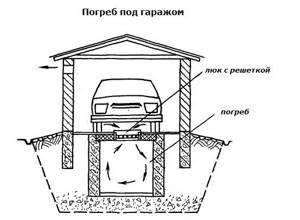
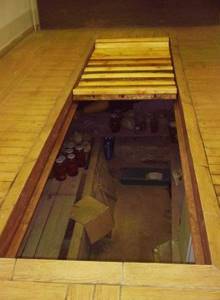
when building in damp soil with a high groundwater level, the walls of the storage facility are made of monolithic concrete of increased density and water resistance; the depth of the structure is 1.8-1.9 m;- The walls of a cellar under a garage, built in a dry place, can be lightweight. As an option - standard asbestos-cement corrugated slate sheets, laid in 2 layers, glued with bitumen mastic (cement-casein glue: 2 parts of dry casein + 1 part of cement, mixed to the consistency of sour cream), secured with screws on a wooden frame;
- it is necessary to ensure water resistance and good ventilation of the structure being built (for more details, see the articles on ventilation and waterproofing);
- waterproofing of pre-primed enclosing structures is carried out with hot bitumen in 2 stages;
- To ventilate the cellar under the garage, use a ventilation pipe with 2 channels (at the same time providing air supply and exhaust) or a hatch equipped, in addition to the lid, with a grille. For insulation, insulation material, such as an old blanket, is placed on top of the grille.
.
Awnings
One of the simplest kitchen designs is open, on a light foundation, on supports and with a pitched roof made of wood and ondulin. For those who like to cook on a grill or barbecue, this open design is best suited - it’s not hot to cook, and the smoke disappears quickly.
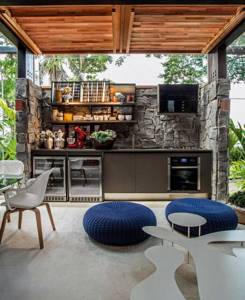
You can put garden furniture under the canopy. If you attach trellis walls to the canopy, you get a pergola kitchen.
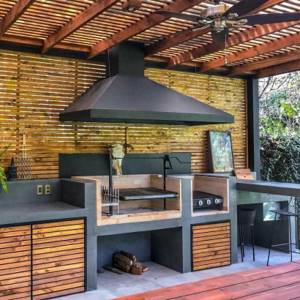
Waterproofing basement walls
To ensure water resistance, concrete and brick walls are additionally plastered with cement mortar. After the layer of plaster has completely dried, bitumen mastic is applied to the outside of the wall, onto which roofing material is glued (Fig. 11), after which soil is backfilled.
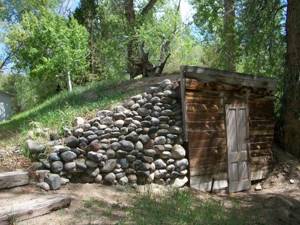
To ensure the watertightness of your building, it is necessary to waterproof the walls
Advice! To improve waterproofing, instead of backfilling with soil, you can make a clay castle. To do this, clay is mixed with water and coarse sand until a plastic mass resembling plasticine is formed. The resulting mass is placed in a pit between the walls and the ground, compacting it very tightly.
Rice. 11. Waterproofing cellar walls using bitumen mastic and roll materials
Advantages of a separate summer kitchen
A kitchen that is not combined with the owner’s house has a number of obvious advantages:
- the ability to choose a prefabricated structure;
- cooking over an open fire;
- use as a gazebo just for relaxing in the fresh air.
If the summer kitchen is a separate house, and in winter it is possible to heat the room and organize a sleeping place, then such a building is more likely not just a kitchen, but an outbuilding. But for the summer, it’s still better to use the open option to cook and dine in the fresh air - that’s what it’s for, a summer kitchen.
How to arrange an extension to a house or cottage: legal advice
How to legalize a non-permanent extension? It's actually very easy to do this. First of all, you need to find a local technical inventory bureau (BTI). After this, a complete package of documentation for the house is collected, which should be taken to the above-mentioned authority. The bureau draws up a special application for amendments to technical house documents. This can be done both before the construction of the extension begins and after. The question of which of these two options is more convenient is obvious. The best option would be to design an already constructed non-capital facility, because all the data is already known exactly, and major changes are unlikely to follow. But there is one small problem here. Although this is unlikely, the BTI may refuse permission for an extension. Of course, there must be serious reasons for this. That is why it is better to play it safe and coordinate the construction of a non-capital type facility in advance.
A house extension project can be called a reconstruction of an existing building. Legalizing a capital additional structure is not as simple as a non-permanent one. However, there are quite a large number of options here that you can act on legally. The most common and convenient way to register an additional object is to register an “unauthorized building”. We are talking about those cases when the registration of an object occurs after its construction. To avoid problems, it’s worth calculating and preparing everything correctly. The following documents must be collected:
Equipment for summer kitchen
Before designing a kitchen, you should clarify what exactly it is needed for and what equipment will be installed. Under a compact canopy you can only put a grill or barbecue and some furniture.
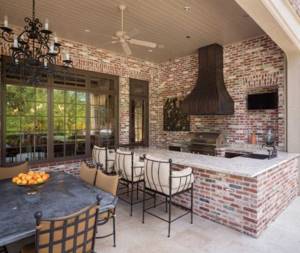
If you plan to install a stove, it is laid out from bricks or stones. A master stove maker will help you build a tandoor or a small stove for a summer kitchen and lead the pipe through the roof, if necessary. For more complex equipment, such as stoves and sinks, it is worth including protection from wind and rain in the design.
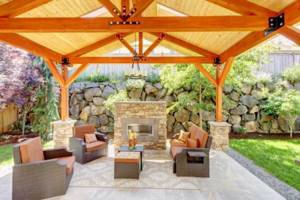
Construction of cellar walls and ceiling
The walls of the cellar will be subject to significant lateral loads from the soil (bulk or continental) and must resist them. The walls can be made of brickwork, solid concrete (using TISE technology or poured into formwork) or wood.
For bricklaying walls, only red, well-burnt or even burnt bricks are used. The wall thickness must be at least 25 cm (1 brick). There should be a gap of 20-25 cm between the wall of the pit or embankment to install a clay castle. Once the masonry of the walls has been completed and they have gained strength, they are waterproofed using the end parts of roofing felt rolls left when waterproofing the bottoms, and clay locks. The roofing material sheets are bent upward, and their joints are carefully coated with bitumen mastic.
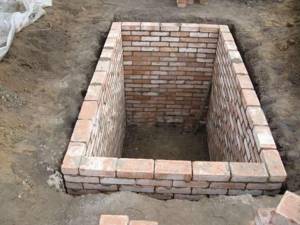
Red brick is used for laying brick walls in the cellar. There must be a gap between the wall and the embankment for a clay castle - a layer of compacted clay laid along the edge of the underground part of the wall.
If a partially buried or above-ground cellar is installed, then after the walls are erected, the embankment is also erected. As it is erected, a clay castle is installed layer by layer. It is made from greasy crushed clay and has a thickness of about 20 cm. It is advisable to make the embankment from turf or other fertile soil, because subsequently, the hill formed by the embankment can be used ala the construction of an alpine hill or planting sun-loving crops.
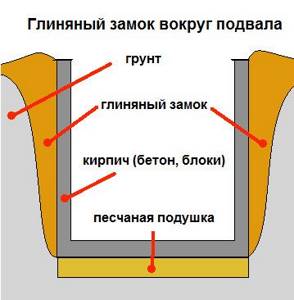
When constructing walls and embankments, an entrance opening is also constructed. The entrance opening is contoured with wood so that a double door can be installed. Parts of the embankment adjacent to the entrance are protected from crumbling by brickwork or poles.
It is preferable to arrange the entrance to the above-ground cellar on the north side and make the wall on the north side slightly higher than on the south. This will allow you to build an upper ramp with a slight slope, sufficient to drain sediment from the entrance opening.
The top roll is made up of thick poles, blocks or logs connected to each other with staples or slats. A polyethylene film and a layer of expanded clay are applied over the knurling to generally level the surface. The remaining parts of the roofing felt panels are bent onto a leveled rolling plane and connected using bitumen mastic. A layer of crumpled clay is applied on top of the roofing material and finally covered with turf soil, completing the embankment hill.
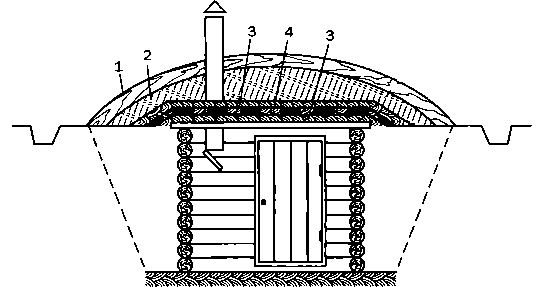
Construction of the cellar roof: 1 - turf; 2 - clay; 3 - roofing material; 4 — roll up.
When making the top roll, it is necessary to provide one or two holes for ventilation pipes and waterproof them accordingly. These holes can be made from a wooden pipe with a cross-section of 20x20 cm, knocked together from tightly fitting boards and wrapped in two layers of roofing felt, or from plastic pipes with approximately the same cross-section.
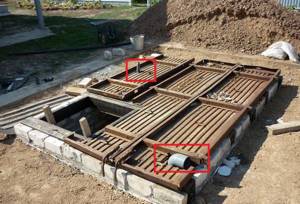
Pipes for ventilation of a deep cellar
The walls of a recessed cellar located under a house or summer kitchen can also be made of brick, concrete or wood. Fundamentally, the walls of a buried cellar and a ground cellar differ slightly. Here we will look at the construction of concrete walls by pouring into formwork.
Four corner posts (or more, not only in the corners, but also, for example, in the center of the walls), made of thick boards, are installed vertically on the bottom. The upper ends of the pillars are fixed to the beams of the lower floor, and formwork is nailed to the lower parts to a height of about 0.5 m from the outer and inner sides.
Wall formwork design
The inner layer of the formwork is made of cladding boards (lining) with the front side facing the inside of the cellar, and the outer layer is made of slab or other cheap material. The distance between the walls of the formwork should be 20-25 cm.
If there is a thick layer of continental clay under the house or summer kitchen, then the leveled wall of the pit can be used as the outer wall of the formwork and do without a clay castle. In all cases, the remaining parts of the roofing felt panels are bent upward and their joints are coated with bitumen mastic. A clay castle is installed between the roofing material layer and the wall of the pit (for sandy and sandy loam soils). Reinforcement is placed inside the formwork - strips of reinforcing mesh, metal rods, thick steel wire or other steel objects, for example, elements of used metal beds. Inside the cellar, spacers are installed between the opposite walls to prevent the internal formwork boards from bending when concrete is poured into it.
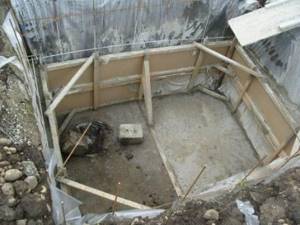
Formwork spacers inside the cellar
After the poured mass of concrete has set, another formwork belt is built up, the clay castle is increased in height, the spacers are rearranged, reinforcement is added (if necessary) and the concrete mass is poured again. This process is completed when the height of the cellar walls reaches 2.0-2.1 m.
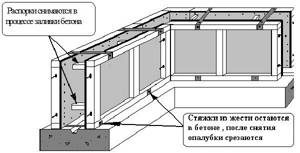
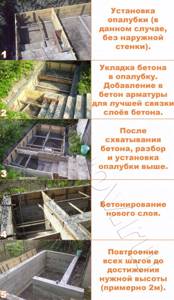
Step-by-step instructions for concreting cellar walls using formwork
A wooden ramp made of blocks, logs or thick poles is laid on the walls of a deep cellar. Holes are cut in the groove for the entrance hatch and ventilation, above which boxes of appropriate sizes are installed and secured. A polyethylene film or sheets of roofing material are laid on top of the roll and a layer of expanded clay or other insulation is placed.
A frame covered with a fine mesh (5×5 mm), an insulating blanket or mattress and a wooden cover are sequentially inserted into the entrance hatch box. A corresponding hole is cut in the floor of the house above the entrance hatch, and a floor cover is made from the cut out parts of the boards, which is attached to the floor using hinges. Two holes are drilled in this cover and a groove for a recessed handle is selected between them (picture below).
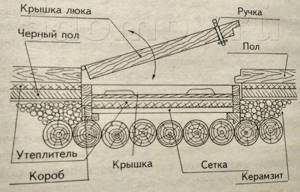
Installation of the ceiling (roll-up) of a buried cellar
The finished cellar should be well dried. Any electric heating device and fan are used for this purpose.
A ladder is used to enter the deep cellar. The upper ends of the strings of this ladder are equipped with special hooks, with the help of which it is attached to the entrance hatch box, protecting it from accidents. If necessary, in the winter the staircase can be easily removed from the cellar and hidden.
Interesting ideas
The design of a summer kitchen can be simple and laconic or thought out to the smallest detail and with interesting decor - it all depends on taste and budget.
How to build a cellar-basement under a garden house
A basement is understood as a recessed room in a house, the floor of which is below ground level (blind area, sidewalk) by more than half its height. If the room is located like this, then most of it is above ground level; it is called a semi-basement or basement. How to build it yourself:
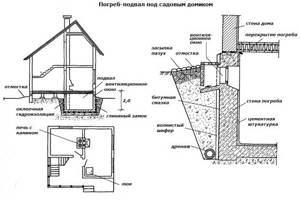
- the cellar-basement under the garden house can be small in size. In this case, its depth is equal to the height of the strip foundation;
- the earthen base of the cellar-basement is compacted and the concrete floor is poured over it in a layer 60-80 mm thick;
- the walls of the cellar-basement are plastered with cement mortar and whitened with lime;
- for waterproofing, use 2 layers of roofing material glued to hot bitumen, as well as a clay castle;
- ventilation - through windows located in the basement of the house;
- Entrance to the cellar-basement is through a hatch in the floor of the house. The hatch cover is double made of floorboards with insulation, equipped with an iron ring as a handle, sealed in place;
- it is convenient to build a garden house and a cellar-basement under it, located at different levels. In this case, the entrance to the semi-basement with a cellar is arranged from the street (see picture).
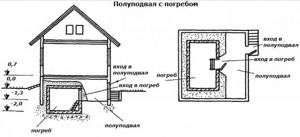
.
Kitchen gazebo
In this case, the summer kitchen forms a single structure with the gazebo, but externally the two rooms may have different shapes - the rectangular kitchen block seems to flow into a round gazebo.
The spacious rectangular gazebo can be divided into two parts - a cooking area and an open dining veranda with a table and chairs. In the photo, summer kitchens in the country, combined with a gazebo, are a convenient and practical option.
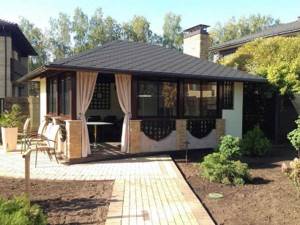
Construction documents
Until recently, country houses and garden houses were built without permits (individual housing construction required a building permit).
Not really, the notification procedure is now in effect. A special document is provided - notice of planned construction . It applies either to a residential or garden house. The requirements are the same.
The notification is a paper document with the following information:
- name of the administration to which the application is submitted;
- information about the applicant (developer). Full name, registration address, passport details, postal address (you can specify email) for communication;
- information about the land where construction is to take place. Cadastral number, address, type of use right of the applicant (ownership, lease, etc.), existence of rights to the land by other persons (mortgage, easement, etc.), purpose of the site (as stated in the cadastral extract);
- information about the object. Type of real estate (residential/garden), type of work (construction or reconstruction), number of floors, total height, footage of housing, setbacks from the boundaries of the site on all sides, etc.;
- graphic image of an object. The diagram is depicted directly in the notification in a special frame. The parameters do not have to be observed; it is important to reflect the location on the land plot;
- other information and consents: method of notifying the applicant about the consideration of his application, consent to the processing of personal data (a separate signature is placed), confirmation that the structure will not be divided into independent real estate objects, that is, indivisible (a separate signature is placed);
- final signature and date.
This notice is supplemented by title documents for obtaining permission to build a house on a garden plot. It is copies of land documents confirming the right. If the applicant's right is registered, then such documents are attached at the discretion of the gardener. If the land has not yet been registered in Rosreestr, submission is required.
The rules for building a house on a summer cottage, which is located in the historical part of the village, have one feature. The construction of real estate in such a place must correspond to the cultural and historical ensemble. The external appearance of the housing is independently agreed upon by the local administration and the religious committee.
But the citizen needs to provide an external description of the planned property as part of the notification documentation. It is made in text format (the architectural solution is described in detail, including the color scheme) and a graphic image (appearance from different sides along the entire height).
What time are authorities notified?
Before starting construction, you need to obtain approval from the administration. That is, first a petition is submitted, and after approval, the object can be erected. Otherwise the property will be illegal.
Yes, you can. The law introduced a special transition period. Already during the construction process, construction activities can be coordinated. If the gardener began his construction before 08/04/2018, then he can submit a notification up to 03/01/2019. And then it will not be taken into account that construction is already in full swing.
Where and how to apply
Documents for registering ownership of a house on a summer cottage in 2021 are submitted to the local administration. The department that issues building permits for other objects (commercial, non-residential), most often this is the department (department, committee, etc.) for urban planning and architecture.
If the land where the house is being built is located on lands of special status (for example, for environmental purposes), then these lands are managed by special committees. As a rule, of regional significance. This is where all documentation is sent.
You can submit documents:
- in person to the office of the local administration (department of urban planning and architecture);
- through the MFC;
- by registered mail with notification (there is no need to have documents certified by a notary);
- using the Gosuslugi portal.
What decision does the municipality make?
According to the rules for building a house on a SNT site, in response to an appeal from the landowner, the municipality gives approval for the upcoming construction or refuses.
When it is possible to build, the administration (department of urban planning and architecture) sends its notification that the house meets all the requirements and the permissibility of construction. This permit is sent to the gardener within 7 working days . And when the house is in the zone of historical cultural monuments, the deadline for sending a response is 20 working days .
If there is no response from the authorities within the specified period, this is regarded as approval.
The validity period of the notice of permissibility of construction is 10 years .
- the object does not meet technical parameters;
- construction contradicts the purpose (UR) of the land plot;
- if the applicant does not have any right to the land or the right has not been agreed upon (for example, the plot is leased and the contract stipulates that construction must be agreed upon with the lessor);
- the land user's documents contain inaccurate data.
Finnish grill house
This is a hexagonal glazed gazebo made of wood with a double door, inside of which there is a barbecue or grill installed clearly in the center with a hood above a round tabletop. Fish, vegetables, and meat are cooked on the hearth.
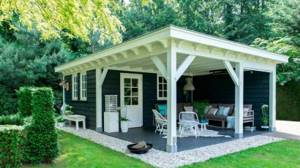
Benches are set up along the perimeter of the gazebo. The grill kitchen is installed on a solid reinforced concrete foundation, the pipe is led out through the roof. The walls are covered with clapboard or block house.
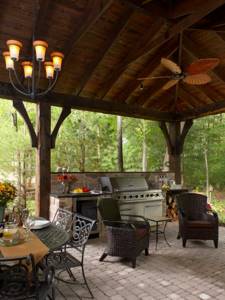
Externally, the house looks like a classic closed gazebo, but inside the space combines three functions - a cooking area, a dining room and a relaxation area.
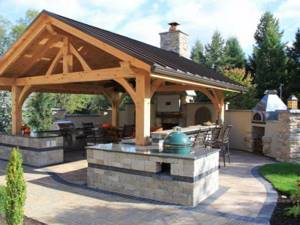
Documents for registration
The procedure for registering a residential building on a garden plot is completed by state registration of real estate in Rosreestr.
But before that the following must happen:
1. Completely build the house (during the period of validity of the municipality’s notification about the permissibility of construction of the facility).
2. Order a technical plan of the house from a cadastral engineer.
3. Fill out and send to the local administration a notice of completion of construction . It is sent no later than 1 month after the construction is ready. It can be submitted in person to the municipality, through the MFC, by mail (registered with notification), through the State Services website.
The form and content of the notification about the completion of construction are the same as about the planned construction. The only difference is in the names of the documents and in the notification of completion of construction, the details of the document on the state fee for registering the right in the state register are additionally indicated.
The following will also be sent to the administration:
- technical plan;
- receipt of state duty (amount of 2000 rubles, details can be obtained from any territorial department of Rosreest or MFC);
- agreement on the distribution of shares (if the site where the house is built belongs to several owners/users).
4. The landowner is sent a notification response from the administration about the compliance of the built house with legal requirements. Delivery time is 7 working days.
The answer may be negative (about the inadequacy of the constructed building). This happens when a building violates the technical parameters, the land on which the house does not have the corresponding VRI, false information is submitted to the administration, etc. In such a situation, it is difficult to imagine how to formalize the construction of a house on a SNT or individual housing construction site.
State registration
The municipal body independently submits an application to Rosreestr to register the right to the house within 7 days. The role of the gardener comes down to the fact that he submitted a notification, a technical plan and paid the state fee. There was no such thing in the legislation before.
The gardener is notified of the submission of the application.
After registration, an extract from the register is sent to the new owner.
If the municipality remains inactive, then the citizen himself can submit an application for state registration. Rosreestr will request all the necessary data from the municipality.
Important! Until March 1, 2021, ownership of previously built objects can be registered using documents (that were relevant at the time, for example, a building permit). After this date, the basis for state registration of rights will only be notification of the planned construction and the conformity of the constructed facility.
Construction of outbuildings
These include garages, bathhouses, sheds, wells, fundamental gazebos, sheds, etc.
Such objects are not subject to the rules for building a house in a dacha cooperative or individual housing construction.
Accordingly, no notifications are sent to local authorities. The entire procedure for legalizing real estate comes down to the preparation of a technical plan for non-residential properties. Then the owner himself submits documentation to Rosreestr consisting of:
- application for registration;
- technical plan;
- state duty receipt (RUB 2,000);
- land title documents.
DIY summer kitchen
Summer residents who do not want to order installation from builders have a question about how to make a summer kitchen with their own hands.
Main works:
- Prepare the foundation. For a closed gazebo or brick structure, it is necessary to arrange a strip foundation. For a lighter structure, it is enough to level the site, lay down the reinforcing mesh and concrete it. The platform should rise above ground level by about 5-10 cm.
- Erect wooden posts and/or build brick walls.
- Build a pitched or gable roof.
- Install a wooden floor or tile it, if necessary.
- Cover the floor and walls with protective materials - fire retardant, antiseptic with wax, varnish.
You can order the production of wooden elements from a specialized company and carry out the assembly yourself. An open wooden shed with a light roof is the easiest and most budget-friendly way to get an environmentally friendly summer kitchen in your country house.
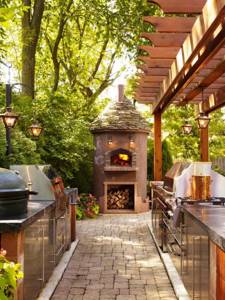
A summer kitchen in the country is a must for gardeners and gardeners who cook a lot. For those who often like to gather in large groups, such a functional design will also be a salvation on summer evenings. There are a large number of summer kitchen projects - everyone will find their own option.
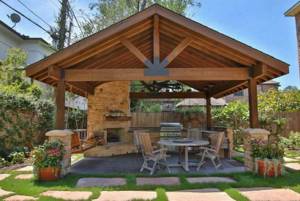
Legalize an unauthorized extension to a private house - procedure
- Legalizing a non-permanent extension will not be particularly difficult; to do this, you need to make appropriate changes to the existing technical documents:
- To do this, you should contact the BTI.
- If there is more than one owner in the house, then it is necessary to provide consent (in writing) of all owners of the premises.
- As soon as the BTI finishes making changes to the documents, the procedure can be considered completed.
- A major extension can be legalized before and after construction. In the first situation, construction is carried out according to an already existing project and the owner has all the permitting papers in hand. In this case, its construction occurs legally:
- For this to happen, you first need to collect all the necessary papers and submit them to the architecture department in the local municipality. If the papers are in complete order, then the authorities will issue the appropriate approval.
- The last step will be to pay the state fee and visit Rosreestr to register the extension.
- To legitimize an unauthorized building, if the administration has not issued a permit, you must proceed as follows:
- Collect the required papers.
- Appeal to the court. The collected documentation is accompanied by a statement of claim for recognition of ownership rights to a building built independently. The plaintiff will be the owner of the land and the main building, and the defendant will be a representative of the administration. The judge may require the written consent of all persons registered in the premises. Once permission is received, you can move on to the next stage.
- It is necessary to contact the appropriate authority that deals with issues related to registration of new ownership of the premises. Civil servants will issue a receipt with the amount required to pay for the extension. The state duty is calculated in accordance with the Tax Code.
Due to the illegality of construction, the building cannot be sold, given away, donated, exchanged or inherited in the future. In this situation, you need to consult a specialist; together with him you need to review all the available papers for the site and the house, and also think about further actions.
30 Jun 2021 hiurist 1161
Share this post
- Related Posts
- Is it possible to evict a disabled person of the first group for debts?
- Why is there no payment for a Veteran?
- Tobacco Law 2021
- Can bailiffs seize property if the debtor is on maternity leave?
